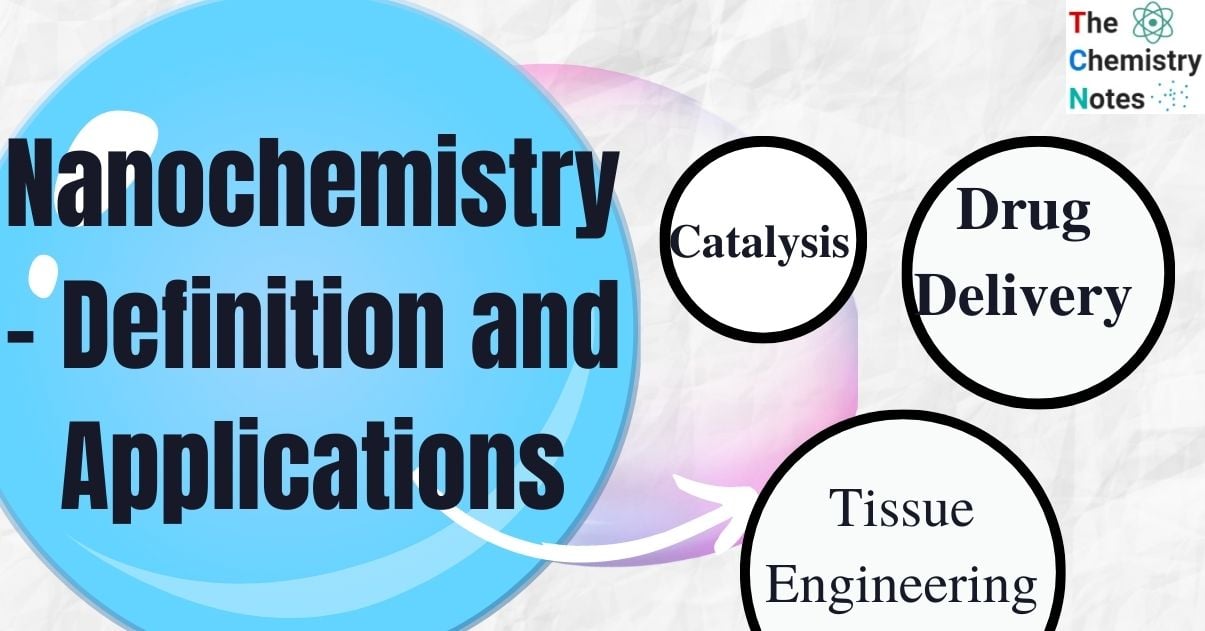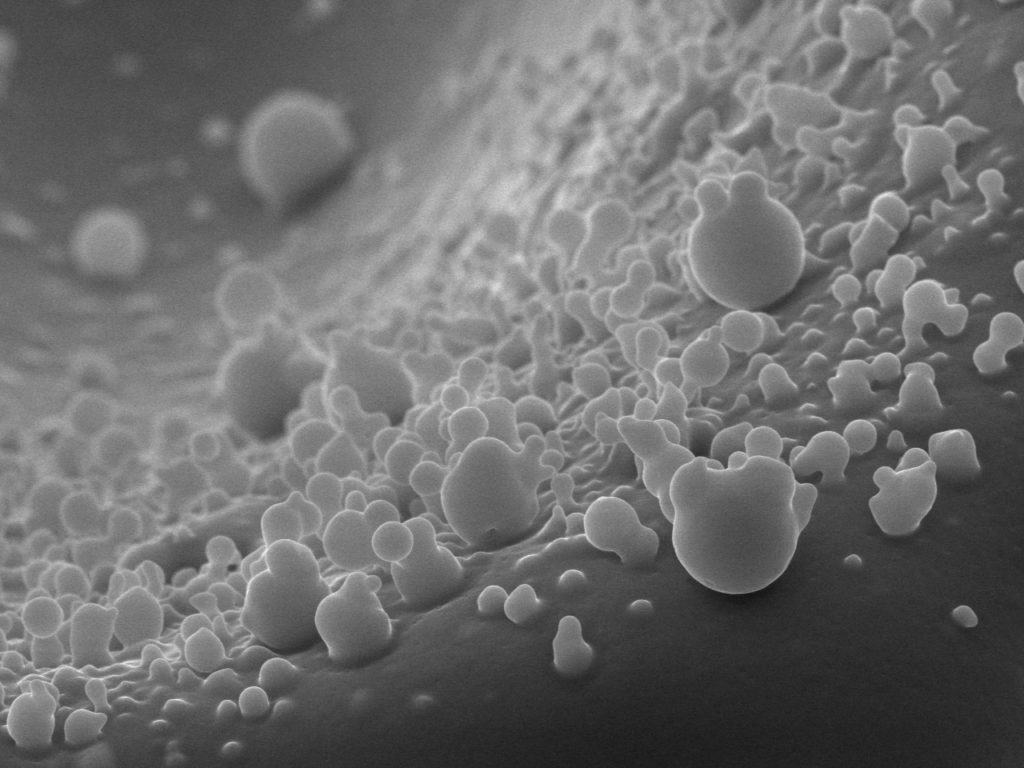Nanochemistry is a novel approach to building devices with molecular scale precision, atom by atom. It entails researching the synthesis and characterization of nanoscale materials, with a focus on how atoms behave and interact, as well as how they can be manipulated and controlled in chemical reactions at the atomic level. Nanochemistry researchers work from the atom up, with the goal of engineering nanosized materials.

What is Nanochemistry?
Nanochemistry is a subfield of nanotechnology concerned with the chemical applications of nanomaterials in nanotechnology. It entails the synthesis and manipulation of materials at the atomic and molecular levels, as well as the investigation of their physical and chemical properties.
The study of chemistry at the nanoscale is known as nanochemistry. One nanometer is one billionth of a meter. To better understand this extremely short length, a human hair can be shown to be 100,000 nanometers thick. Thus, a material must have at least one dimension of 1-100 nm to be considered a nanomaterial.
Nanoscale science and technology have advanced rapidly in recent years. Nanochemistry, in particular, offers a novel method for creating devices with molecular-scale precision. Nanodevices have potential applications in medicine, computing, scientific exploration, and electronics, as nanochemistry holds the promise of building objects atom by atom. Because nanoscale systems exist at the boundary between classical and quantum behavior and exhibit behaviors that do not exist in larger devices, the main challenges to fully utilizing nanochemistry revolve around understanding new rules of behavior.

Although nanochemical control was proposed decades ago, many of the tools required for studying the nanoworld have only recently been developed. STMs, atomic force microscopes (AFMs), high resolution scanning and transmission electron microscopies, and new nanofabrication and lithography methods are among them.
Nanochemical system research encompasses a wide range of topics, from the study of individual atom interactions and how to manipulate them to the study of larger molecular assemblies such as dendrimers, clusters, and polymers. Hence, significant new structures, such as nanotubes, nanowires, three-dimensional molecular assemblies, and lab-on-a-chip devices for separations and biological research, have resulted from assembly studies.
Nanoparticle Size
Nano is derived from the Greek word ‘Nanos,’ which is used to represent the billionth fraction of a unit. For example, 1 nanometre equals 1/1,000,000,000 meter.
One nanometre (nm) equals 10-9 or 0.000000,001 meter.
The examples below may help to demonstrate how small the nanoscale is:
- A nanometre and a metre represent the same size difference as a golf ball and the Earth.
- One nanometre is one-twenty-five thousandth the diameter of a human hair.
- A cell membrane is approximately 9 nm wide.
- The DNA double helix measures 2 nm across.
- One hydrogen atom has a diameter of approximately 0.2 nm.
Applications of Nanochemistry
Nanochemistry is used in chemical, physical, and materials science, engineering, biology, and medicine. Using single atoms as building blocks allows for new ways to create innovative materials, the ability to create the smallest features possible in integrated circuits, and the opportunity to investigate quantum computing.
Catalysis : Nano-enzymes (or Nanozymes)
Because of their small size (1-100 nm), nano-enzymes (or nanozymes) have unique optical, magnetic, electronic, and catalytic properties.
Furthermore, the ability to control nanoparticle surface functionality and the predictable nanostructure of these small-sized enzymes has allowed them to create a complex structure on their surface that can meet the needs of specific applications.
Cosmetics
Materials in cosmetics such as sunscreen, moisturizer, and deodorant may benefit from the use of nanochemistry. Manufacturers are working to improve the efficacy of various cosmetics through the use of oil nanoemulsion. These particles have pushed the boundaries in the treatment of aging skin wrinkling, dehydration, and inelasticity. Titanium dioxide and zinc oxide nanoparticles are effective UV filters in sunscreen, but they can also penetrate the skin. These chemicals protect the skin from harmful UV light by absorbing or reflecting it and preventing the skin from retaining full damage caused by photoexcitation of electrons in nanoparticles.
Drug Delivery
Emerging drug delivery methods involving nanotechnology can be beneficial by improving bodily response, specific targeting, and non-toxic metabolism. Many nanotechnological methods and materials can be drug-delivery functionalized. In order to transport a drug cargo into the body, ideal materials use a controlled-activation nanomaterial. Mesoporous silica nanoparticles (MSN) have grown in popularity in research due to their large surface area and flexibility for various individual modifications while maintaining high-resolution imaging performance.
Nanodiamonds have recently shown promise in drug delivery due to their non-toxicity, spontaneous absorption through the skin, and ability to cross the blood-brain barrier.
Carbon nanotubes’ unique structure also inspires many innovative medical method inventions. They are becoming a stronger candidate in new detection methods as well as therapeutic strategies as more medicine is made at the nano level to revolutionize the ways humans detect and treat diseases. Carbon nanotubes, in particular, can be transformed into sophisticated biomolecules and detected via changes in the carbon nanotube fluorescence spectra. These nanotubes can also be designed to match the size of a small drug and endocytosed by a target cell, transforming them into a delivery agent.
Tissue Engineering
The optimization of surfaces in tissue engineering has pushed toward implantation because cells are very sensitive to nanotopographical features. A carefully crafted 3-dimensional scaffold is used to direct cell seeds toward artificial organ growth under the right conditions. For optimal and appropriate functionality, the 3-D scaffold incorporates various nanoscale factors that control the environment. The scaffold is an in vitro analog of the in vivo extracellular matrix, allowing for successful artificial organ growth by supplying the required, complex biological factors.
Wound Healing
Nanochemistry has demonstrated applications in improving the healing process of abrasions and wounds. Electrospinning is a polymerization method that can be used for wound dressing and drug delivery in addition to tissue engineering. In a controlled environment, this produces nanofibers that promote cell proliferation as well as have antibacterial properties. These properties are visible at a macroscale, but nanoscale versions may be more efficient due to nanotopographical features. In vivo, targeted interfaces between nanofibers and wounds have higher surface area interactions. There is also an evidence that certain silver nanoparticles can inhibit some viruses and bacteria.
Applications of Nanochemistry can be summarized as:
- Metallic nanoparticles have the potential to be very active catalysts.
- Chemical sensors made of nanoparticles and nanowires improve sensitivity and sensor selectivity.
- Nano coatings and nanocomposites have been found to be useful in the manufacture of a wide range of products, including sports equipment, bicycles, and automobiles.
- These are also used as novel UV-blocking coatings on glass bottles to protect beverages from sunlight damage.
- Nanotechnology is being used in the creation of synthetic skin and implant surgery.
- Nanomaterials that conduct electricity are used as minute conductors in electronics to create circuits for microchips.
- Nanomaterials are widely used in the production of cosmetics, deodorants, and sunscreen lotion, and they are also used to improve moisturizers without making them too oily.
- Nanoparticle substances are incorporated into fabrics to inhibit the growth of bacteria.
- Nanomaterials are used in biomedical devices such as drug infusion pumps, microneedles, and glucometers.
- Nanochemistry is used in the manufacture of space, defense, and aeronautical devices.
References
- J.W. Steed, D.R. Turner, K. Wallace Core Concepts in Supramolecular Chemistry and Nanochemistry (Wiley, 2007) ISBN 978-0-470-85867-7
- Brechignac C., Houdy P., Lahmani M. (Eds.) Nanomaterials and Nanochemistry (Springer, 2007). ISBN 978-3-540-72993-8
- H. Watarai, N. Teramae, T. Sawada Interfacial Nanochemistry: Molecular Science and Engineering at Liquid-Liquid Interfaces (Nanostructure Science and Technology) 2005. 321p. ISBN 978-0-387-27541-3
- https://www.twi-global.com/technical-knowledge/faqs/what-are-nanoparticles#:~:text=A%20nanoparticle%20is%20a%20small,to%20100%20nanometres%20in%20size.
- https://www.azonano.com/article.aspx?ArticleID=4830
- https://www.grace.edu/what-is-nanochemistry-a-faculty-blog-by-andrew-zhou/
- https://www.encyclopedia.com/science/news-wires-white-papers-and-books/nanochemistry
- https://en.wikipedia.org/wiki/Nanochemistry
